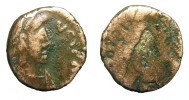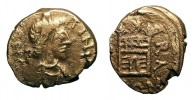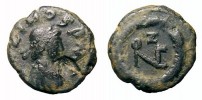| Last additions - Jan |

Phocas - RavennaPhocas (-610), Byzantine emperor (602-610). Æ 20 Nummi (15 mm, 3.66 g), Ravenna. Obverse: crowned, draped, and cuirassed facing bust. Reverse: large XX with star between, RAV in exergue. SB 707; MIB 113; Ranieri 527. JanDec 02, 2009
|
|

Claudius - Gadara, DecapolisClaudius (41-54 AD). Æ (18 mm, 4.41 g). Gadara, Decapolis, Syria. Struck 50-51 AD.
Obverse: laureate head of Claudius right.
Reverse: turreted and veiled head of Tyche right; date LDIP (year 114 = 50-51 AD) to right.
Reference: Spijkerman 19.JanNov 07, 2009
|
|

Tiberius II Constantine - RavennaTiberius II Constantine (-582), Byzantine emperor (574-582). Æ 10 nummi (14 mm, 3.27 g), Ravenna or Sicilian mint. Obverse: crowned facing bust, holding globus cruciger. Reverse: large I between two crosses. DOC I 66 (Ravenna); SB 472 (Ravenna); Hahn, Numismatic Circular, 1979, p. 553 (Sicily).JanNov 07, 2009
|
|

Theoderic the Great - Ravenna - 5 nummiTheoderic the Great (454-526), Ostrogothic king (471-526), ruler of Italy (494-526). Æ 5 Nummi (15 mm, 1.67 g), Ravenna. Obverse: crowned head of Ravenna right, [FELIX R]-AVENNA (retrograde). Reverse: Victory advancing left, holding wreath and palm branch, R-V in fields. Metlich 81; Ranieri 252-4; MEC –.
Rare. Metlich (2004) cites six coins, four of which are in museums (Ravenna, Milan, Torino, Vienna), and suggests that they belong to the very earliest of Theoderic's Æ coinage from the 490's. This is the only Æ coin of Theoderic that is believed to belong to Ravenna; all other Æ coins where minted in Rome.
Ex Dix Noonan Webb 2009, A8, Lot 5968.JanNov 07, 2009
|
|

Theoderic the Great - Rome - 10 nummiTheoderic the Great (454-526), Ostrogothic king (471-526), ruler of Italy (494-526). Æ 10 Nummi (16 mm, 2.72 g), Rome. Obverse: crowned head of Ravenna right, FELIX R-AVENNA. Reverse: Eagle left between two stars, X in exergue. Metlich 77; Ranieri 255-6; MEC –.
Approximately 20-30 coins known. Metlich (2004) cites thirteen coins in museums and sold at major auctions. Metrological evidence suggests that this type was emitted at about the same time as the more common type with the Ravenna monogram on the reverse (Metlich, 2004).JanNov 07, 2009
|
|

Theoderic the Great - Rome - 10 nummiTheoderic the Great (454-526), Ostrogothic king (471-526), ruler of Italy (494-526). Æ 10 Nummi (16 mm, 2.32 g), Rome. Obverse: crowned head of Ravenna right, FELIX R-AVENNA. Reverse: monogram of Ravenna, cross above, all in wreath. Metlich 78b; MIB 72b; MEC 150; Kraus 5.
This type with a cross above the monogram is less common than the type without a cross. The minting is believed to have continued into the reign of Athalaric (526-536) (Metlich, 2004). The existence of two hybrid coins where the Ravenna monogram reverse is combined with an INVICTA ROMA obverse indicates that the coins may have been produced in Rome (Metlich, 2004).JanNov 01, 2009
|
|

Aethelred II - Canterbury, EnglandAethelred II (968-1016). King of England 978-1013 and 1014-1016. AR (20 mm, 1.62 g) penny of long cross type struck at Canterbury; moneyer Leofric.
Obverse: ÆTDELRÆD REX ANGLO.
Reverse: LEOFRIC M O CÆNT.
References: North 774; Sear 1151.JanNov 01, 2009
|
|

Athalaric - Rome - 20 nummiAthalaric (516-534), Ostrogothic king (526-534). Æ 20 Nummi (22 mm, 6.15 g), Rome. Obverse: helmeted bust of Roma right, INVIC-TA ROMA. Reverse: lupa left, Romulus and Remus, star I star above, XX in exergue. Metlich 84a; MIB 71b.JanNov 01, 2009
|
|

Athalaric - Rome - 10 nummiAthalaric (516-534), Ostrogothic king (526-534). Æ 10 Nummi (17 mm, 3.11 g), Rome. Obverse: helmeted bust of Roma right, INVICT-A ROMA. Reverse: king standing right holding spear and shield, DN ATAL-ARICVS, S-C, X in left field. Metlich 85a; MIB 77.
This coin is said to have been found in North Yorkshire, England. It does not appear to have been in circulation for a long time, and the find is an interesting indication of contacts with the continent during the Early Middle Ages.JanNov 01, 2009
|
|

Theodahad - Rome - 10 nummiTheodahad (c. 480-536), Ostrogothic king (534-536). Æ 10 Nummi (3.72 g, 17 mm, 6 h), Rome. Obverse: helmeted bust of Roma right, INVICT-A ROMA. Reverse: DN/THEODA/HATHUS/REX within wreath. Metlich 90; MIB 82; MEC 1, 144.
Ex. Giamba collection; Ex. CNG 82, lot 1130, 2009JanNov 01, 2009
|
|

Hilderic - Carthage, Vandal kingdomHilderic (460s-533), king of the Vandals and Alans (523-530). Æ nummus (8 mm, 0.62 g), Carthage. Obverse: diademed head right, [HILD]IRIX. Reverse: cross in wreath. Grierson/Blackburn 24-5.JanNov 01, 2009
|
|

Bronze nummus - Vandal kingdomVandal kingdom. Æ nummus (10 mm, 0.45 g). Obverse: Diademed and draped bust right. Reverse: Eagle or zoomorphic deity within wreath. Wroth 3:18.
Very rare. A similar coin in British Museum (Wroth 3:18) was purchased from Mr. J. Doubleday in 1849 and was believed to originate from Northern Africa. Probably struck in the Vandal kingdom during the time period from c. 450 to 530. One possibility is that the coin imitates Ostrogothic 10 nummi coins with an uppright eagle minted in Rome for Theoderic the great. The vandal king Thrasamund was married to Amalfrida, the sister of Theoderic, from 500 to 523 AD. The coin may perhaps have been struck during this time period. Another possibility is that the reverse shows the Egyptian god Anubis. Comments and alternative interpretations are welcome.
Ex Poncin collection; CNG 134, lot 455, 2006; Beast Coins Auction I, lot 205, 2009JanNov 01, 2009
|
|

Imitative issue - Vandal kingdomVandal kingdom. Æ nummus (10 mm). 5th century, imitating contemporary roman bronze coins. Obverse: Diademed and draped bust right. Reverse: Victory with wreath advancing left.JanNov 01, 2009
|
|

Majorian (undescribed, similar to RIC X 2650)Majorian (420-461), Western Roman Emporer (457-461). AR half-siliqua (0.53 g, 11 mm), Arles. Obverse: (D N IVLI) MAIOR(IANVS), pearl-diademed, helmeted, draped, and cuirassed bust right, holding spear and shield with Christogram. Reverse: Victory standing left, holding long cross, V(ICTORIA AVGG), dotAxR in exergue. Similar to RIC X 2650, but obverse legend not in RIC and exergue undescribed.
The exergue AxR is to the best of my knowledge undescribed and indicates that the coin may be attributed to Arles. It thus suggests that silver coins where minted in Arles under the rule of Majorian, while Kent (RIC X) attributed similar coins to an unknown mint in northern Gaul. This coin has an obverse die match with a coin sold by CNG (CNG 72, lot 1942, 2006). The coin sold by CNG had the more common exergue consisting of stars and dots, and the die link thus indicates that at least some of the coins listed as RIC X 2650-2653 may have been minted in Arles.JanNov 01, 2009
|
|

Leo I (RIC X 683-688)Leo I (401-474), Eastern Roman Emperor (457-474). Æ (10 mm, 1.16 g), Constantinople. Obverse: DN LEO PF AVG or similar. Reverse: latin monogram in wreath, CO(N) in exergue. RIC X 683-688, any one of them.JanNov 01, 2009
|
|

Honorius brockageBrockage error on a late roman bronze coin (11 mm, 1.41 g), probably Honorius. The obverse design is mirrored on the reverse, which was caused by an already minted coin that stuck to the die and impressed onto another coin. JanNov 01, 2009
|
|

Theodosius II (RIC X 432 var.)Theodosius II (401-450), Eastern Roman Emperor (408-450). Æ (12 mm, 1.26 g), minted in Heraclea 425-435. Obverse: DN THEODO-SIVS PF AVG. Reverse: Victory holding wreath in each hand, CONCO-RDI AVG (retrograde), SMH in exergue. RIC X 432 var., R.
Not in RIC. Reverse usually CONCOR-DIA AVG, and obverse legend without break.
JanNov 01, 2009
|
|

Theodosius II (RIC X 443)Theodosius II (401-450), Eastern Roman Emperor (408-450). Æ (11 mm, 0.91 g), minted in Constantinople 425-435. Obverse: DN THEODOSIVS PF AVG. Reverse: cross in wreath, CONS in exergue. RIC X 443, R.
JanNov 01, 2009
|
|

Valentinian III (RIC X 2160)Valentinian III (419-455), Western Roman Emperor (425-455). Æ (12 mm, 1.34 g), Rome. Obverse: DN VAL(EN)TINI(ANO). Reverse: campgate, (CAS)-TRA, ROM in exergue. RIC X 2160, C.JanNov 01, 2009
|
|

Marcian (RIC X 543)Marcian (396-457), Eastern Roman Emperor (450-457). Æ (10 mm, 1.35 g), Constantinople. Obverse: DN MARCIANVS PF AVG. Reverse: monogram type 2 in wreath, CON in exergue. RIC X 543, R.JanNov 01, 2009
|
|

Honorius (RIC X 1357)Honorius (384-423), Roman Emperor (393-395) and Western Roman emperor (395-423). Æ (11 mm, 1.15 g), Rome. Obverse: DN HONORI-(VS PF AVG). Reverse: (VICTOR)-IA AVGG, Victory advancing left with wreath and palm branch, RM in exergue, T in left field. RIC X 1357, C.JanNov 01, 2009
|
|

Johannes (RIC X 1913)Johannes (-425), Western Roman usurper (423-425). Æ (11 mm, 1.22 g), Rome. Obverse: DN IOHANN-ES PF AVG. Reverse: SALVS REI-PVBLICAE, Victory advancing left, holding trophy on shoulder and dragging captive, RM in exergue, chi-rho in left field. RIC X 1913, R3.
Ex. Lanz Online Auctions 2009.JanNov 01, 2009
|
|

Zeno (RIC X 958 var.)Zeno (c. 425-491), Eastern Roman Emperor (474-475, 476-491). Æ (9 mm, 0.83 g), Thessalonica. Obverse: D N ZINOS PMC. Reverse: monogram 1 in wreath. RIC X 958 var., S.
Legend almost fully visible on this 9 mm coin! The reverse appears to be designed without the THS in exergue expected for RIC X 958.JanNov 01, 2009
|
|

Zeno (RIC 961, 963 or 965)Zeno (c. 425-491), Eastern Roman Emperor (474-475, 476-491). Æ (9 mm, 1.05 g), Constantinople or Cyzicus. Obverse: star ZE(...) (retrograde). Reverse: monogram 4 in wreath, RIC X 961 (Constantinople), 963 (Constantinople) or 965 (Cyzicus), R.JanNov 01, 2009
|
|

Theodosius II (RIC X 1909)Theodosius II (401-450), Eastern Roman Emperor (408-450). Æ (10 mm, 1.51 g), minted in Rome 423-425. Obverse: DN TH(EODOS-IVS PF AVG). Reverse: (VICTOR)-IA AV(GG), Victory advancing left with wreath and palm branch, RM in exergue and epsilon in left field off flan. RIC X 1909, R4.
JanNov 01, 2009
|
|

Theodosius I (RIC IX Antioch 56c)Theodosius I (347-395), Roman emperor (379-395). Æ (12 mm, 1.02 g), Antioch. Obverse: DN THEODO-SIVS PF AVG. Reverse: VOT/X/MVLT/XX, ANTA or ANT delta in exergue. RIC IX Antioch 56c, C.JanNov 01, 2009
|
|

Anastasius (SB 13)Anastasius (c. 430-518), Byzantine Emperor (491-518). Æ (8 mm, 0.60 g), Constantinople. Obverse: bust right, no legend. Reverse: monogram of Anastasius. DOC I 15; MIB I 40; SB 13.JanNov 01, 2009
|
|
|
|

|
